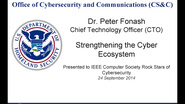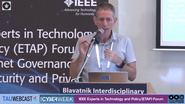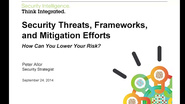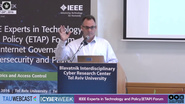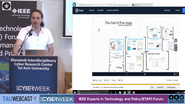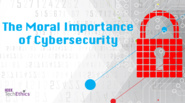Cyber Security
What is Cybersecurity?
Cybersecurity, often known as information security, maintains the integrity, confidentiality, and availability (ICA) of data. Cybersecurity is a constantly developing set of tools, risk management techniques, technologies, training, and best practices to protect networks, computers, applications, and data against assaults or illegal users. The most common threats among cyber-attacks are malware, phishing, ransomware, and viruses.
Common Types of Threat
Malware
Malware, often called malicious software, is invasive software produced by malicious hackers to steal sensitive data or break and ruin computers and other electronic systems. This threat can leak large quantities of data. Malware types include viruses, worms, trojan viruses, spyware, adware, and ransomware.
Phishing
Phishing is an attack that delivers deceptive communications while posing as a reputable source. This is usually done by email or over the phone. The purpose is to steal private information such as financial data or login credentials or implant malware on a target's devices.
Ransomware
Ransomware is a type of malware that encrypts files on a target device, leaving those files and the systems on which they rely inoperable. After encrypting the system, the perpetrators often seek a ransom in exchange for decryption.
Viruses
A virus is destructive software designed to spread from one computer to another, or to any other linked devices. The goal of a virus is typically to provide the attacker with access to infected systems. Several infections masquerade as genuine apps before causing system harm, stealing data, disrupting services, or downloading other malware.
Protection Against Cybersecurity Threats
Protection against many sorts of cybersecurity threats necessitates knowledge of the various types of cybersecurity. The multiple categories frequently collaborate to provide end-to-end security. Some of these types of cybersecurity are:
- Application Security
- Cloud Security
- Infrastructure Security
- Internet of Things (IoT) Security
- Network Security.
Application Security
Application security refers to the security measures apps employ to protect data or code within the software from being exploited or stolen. According to VMware, these security technologies are built throughout application development but are intended to secure the application after deployment.
Cloud Security
Cloud security refers to the technology and practices protecting cloud computing infrastructures from internal and external threats. These security technologies are meant to prevent unwanted access and keep information and applications safe from cyber security risks in the cloud.
Infrastructure Security
Critical infrastructure security refers to physical and cyber systems that are so important to society that their failure would have a crippling effect on physical, economic, or public health and safety. For example, the power grid.
Internet of Things (IoT) Security
The Internet of Things (IoT) refers to any device that connects the Internet and/or other connected devices. Typical examples include appliances, environmental sensors, smart televisions, connected cameras, industrial sensors and industrial actuators. Protecting these devices is critical since security is one of the most significant impediments to mainstream IoT use. IoT devices with poor security have been used by hackers as access points to personal and corporate networks.
Network Security
Network security protects network infrastructure against unwanted access, misuse, or fraud. These security solutions entail building a safe infrastructure enabling devices, apps, and people to collaborate.
Applications of Cybersecurity
Some use and application of cybersecurity are:
- Protecting from malware, ransomware, phishing, and social manipulation in business.
- Safeguarding data and networks.
- Prohibiting unauthorized individuals from gaining access.
- Reducing the downtime and impact of a security breach.
Featured Article
What is cybersecurity threat mitigation?
As digital technology becomes integral to our lives, the risk of exposing sensitive data continues to grow. Cybersecurity threat mitigation helps consumers, businesses, and government entities decrease vulnerabilities and reduce the number and intensity of security incidents.
Cybersecurity incidents such as email phishing and malware attacks have risen since the onset of the COVID-19 pandemic, which finds more people working from home. In addition, security incidents are no longer limited to mobile devices and computers but a host of new products incorporating digital technology, including automobiles, medical equipment, and any smart device using the Internet of Things (IoT).
In this article, we’ll look at the latest trends in cybersecurity threat mitigation, including risk recognition, developments in software, and how experts are responding to rapid changes in cybersecurity.
Categories of cybersecurity threat mitigations
Hackers have unique approaches to launching cybersecurity attacks and are constantly modifying their tactics. Identifying and categorizing threats is a first step in preventing and mitigating security breaches, whether you’re a programmer, system administrator, or IT manager.
What is threat categorization in cybersecurity?
Threat categorization in cybersecurity helps security stakeholders understand different types of cyberthreats and their impact on digital assets. This understanding helps stakeholders deploy the appropriate countermeasures to protect said assets.
Authors of the paper “Classification of Security Threats in Information Systems,” published in Procedia Computer Science, state that digital asset stakeholders can classify cyberthreats by looking at attack techniques and/or threat impacts.
Classifying cyberthreats based on attack technique
Attack technique classification considers three criteria—source, agent, and motivation. The source criterion represents threat origin, which can be internal or external. The agent criterion represents the “actor” responsible for the threat; there are three agent classes: human, technological, and force majeure. And the motivation criterion represents threat cause, which can either be deliberate or accidental.
Classifying cyberthreats based on threat impact
Threat impact classification chiefly uses the STRIDE model, which engineers at Microsoft use to categorize threats. The STRIDE model classifies cyberthreats by considering attack purposes and goals:
- Spoofing: accessing a system illegally by impersonating a user
- Tampering: modifying data maliciously
- Repudiation: taking advantage of tracking breaches to engage in restricted actions
- Information disclosure: exposing previously secure information
- Denial of service: making a service unavailable to users
- Elevation of privilege: obtaining high-level access to a system when unauthorized
What mitigation techniques are most common in each category?
Spoofing attacks (such as phishing, in which a threat actor tricks a user into giving up credentials) are preventable with complicated passwords and multifactor authentication. As for data tampering (including viruses and malware), solid firewalls and monitoring can help prevent it. Users avoid repudiation attacks with login auditing, while strong encryption prevents information disclosure.
Dedicated denial of service (DDOS) attacks (such as a hacker flooding a website with login requests) are complicated to prevent. Most users employ attack detection, IP blacklisting, threat intelligence, and upstream filtering to mitigate these threats. Users can tackle elevation of privilege threats using authorization control, security bug detection, and dependency checking.
The US Department of Homeland Security, addressing the proliferation of increasing cyber-risks in cyberphysical systems and IoT devices, created the Cyber Physical Systems Security (CPSSEC) project to analyze threats and help create solutions by bringing together researchers, businesses, and security experts.
An example of one such solution is Adventium Labs’ Intrinsically Secure, Open, and Safe Control of Essential LayErS (ISOSCELES), which offers developers proprietary reference architecture and development tools to create safe and secure network-connected embedded systems. ISOSCELES is helping hospitals and medical facilities prevent cyberattacks with strengthened cybersecurity countermeasures.
Importance of mitigating cybersecurity threats
Just one spear phishing attack—a carefully crafted email that gives a hacker access to sensitive information—can wreak havoc on sensitive data or financial information. Malware and DDOS attacks can cripple a company’s critical systems or interrupt a supply chain.
An information disclosure attack can expose trade secrets and proprietary information. Preventing or mitigating such attacks is critical for systems administrators, organizations, and businesses. A 2018 report from the US Council of Economic Advisors estimates that cyberthreats cost the US economy between $57 billion and $109 billion in 2016.
Who has to worry about cybersecurity threats?
Nearly every aspect of society is at risk from cybersecurity threats: individuals can be subject to identity theft and can spend years trying to recover credit scores. Businesses and organizations face numerous risks: critical systems can fail during a denial of service attack, and an information disclosure can ruin a reputation. Hospitals and medical centers are increasingly at risk—in 2016 a hospital was forced to pay a ransom of $17,000 to regain access to lost data.
As automobiles incorporate more digital technology for safety (and eventually move to self-driving capabilities entirely) drivers are increasingly exposed to cybersecurity risks. And the US Coast Guard notes that maritime cybersecurity risks could threaten shipping, ports, and supply chains.
Hackers are continually updating and refining their tactics and technology. IEEE’s Beyond CMOS explores the question of hardware security and notes that innovations in digital and quantum computing processes will be critical to cybersecurity in the future. Innovations such as magnetic tunnel junctions and advances in random number generation promise to be critical in hardware security in future.
Best software packages for cybersecurity threat mitigation
Once stakeholders have identified the potential cyberthreats that their digital assets are vulnerable to, it’s important for them to find software to prevent attacks and mitigate damage if they occur. To find the software best suited for their organization’s needs, they’ll need to take an inventory of their technology infrastructure and organization size, as well as unique vulnerabilities.
After assessing their organization’s needs, stakeholders can check out reviews that evaluate cybersecurity software for IT departments and large organizations.
Students, programmers, researchers, engineers, and the like will want to make sure they have robust software to prevent cybersecurity threats. You can read reviews to find highly rated internet security products and decide which ones meet your needs.
How do you know which software package for cybersecurity threat mitigation is right for you?
Security stakeholders can determine which cybersecurity threat mitigation software package is right for them by taking an inventory of their technology and the risks they want to prevent. Changing personal habits (creating complicated passwords, resisting opening attachments, and so on) can be effective.
But stakeholders should avoid relying too much on “cyber hygiene” and look for more vigorous, systems-wide solutions. They should rank cybersecurity needs and research each product carefully and accordingly.
For universities and research centers, it’s more complicated. Security stakeholders there should consider creating risk-mitigation strategies that evaluate risks and vulnerabilities. They should determine budgets and create maps of exactly how technology is integrated into their organizations.
One tool to assist in this process is the IEEE Xplore digital library, one of the world’s largest collections of technical literature in engineering, computer science, and related technologies, with five million documents now available in its vast repository. Security stakeholders can search through this reference to research cybersecurity threat mitigation in more depth.
Future of cybersecurity threats and mitigation
Even before the onset of the COVID-19 pandemic, cybersecurity threats were growing in frequency and sophistication. But since stay-at-home orders have caused a record number of employees to work remotely, cyberattacks have soared.
The World Health Organization, for instance, reports a fivefold increase in the number of attacks on its systems, and internet security firm Kaspersky notes that attacks on Remote Desk Protocols have risen sharply since the coronavirus became a pandemic.
What are the latest trends in cybersecurity threat mitigation?
Cybersecurity experts are being called upon to defend against a range of new threats. Ransomware, in which hackers lock down important data and then extort money to release it, is becoming a growing problem for businesses, hospitals, and local governments. Supply chain attacks that mimic security updates to software have been on the rise. And data theft continues to be a huge risk for companies and organizations.
In addition, government-sponsored hacking between adversaries continues to threaten businesses, hospitals, and other organizations. The United Kingdom’s National Cyber Security Centre notes a surge in coronavirus-related domains, suggesting that hackers are taking advantage of COVID-19 to spread malicious attacks.
Hacking of vehicles, which increasingly rely on digital technology for navigation and crash prevention, is a new and increasingly dangerous risk, as IEEE notes in the article “Driving with Sharks.” Adding to the problem is a growing shortage of cybersecurity experts worldwide. The Center for Strategic and International Studies notes that the United States faced a shortfall of nearly 314,000 cybersecurity professionals in early 2019.
Why is it necessary to predict changes in cyberthreats?
Staying ahead of cyberthreats requires careful planning and rigorous research, since hackers are increasingly developing more sophisticated tactics to breach security. A report from TrendMicro presents examples of new, advanced threats, including persistent malware, phishing, and zero-day attacks.
Predicting and preventing new cyberthreats are critical for businesses and organizations—IBM estimates that each major data breach on average costs a company or organization $3.9 million and a stock share decline of more than 7 percent.
How are cybersecurity professionals reacting to the latest market developments?
In response to a surge in attempted attacks, cybersecurity professionals are reaching into an increasingly varied toolbox of tactics, software, and analysis to prevent and mitigate cybersecurity breaches.
Some cybersecurity firms are employing AI to predict the likelihood of attacks within businesses and organizations. The tactic involves mapping a business’s or organization’s interconnected network and determining where vulnerabilities exist.
Experts suggest that businesses should create cyber incident response plans that set up protocols and delegate authority to employees to respond to crises. To prevent ransomware and other attacks, businesses should educate employees about best practices and create disconnected backups of critical data.
Interested in becoming an IEEE member? Joining this community of over 420,000 technology and engineering professionals will give you access to the resources and opportunities you need to keep on top of changes in technology, as well as help you get involved in standards development, network with other professionals in your local area or within a specific technical interest, mentor the next generation of engineers and technologists, and so much more.
Related topics
No topics related to "Cyber Security"





